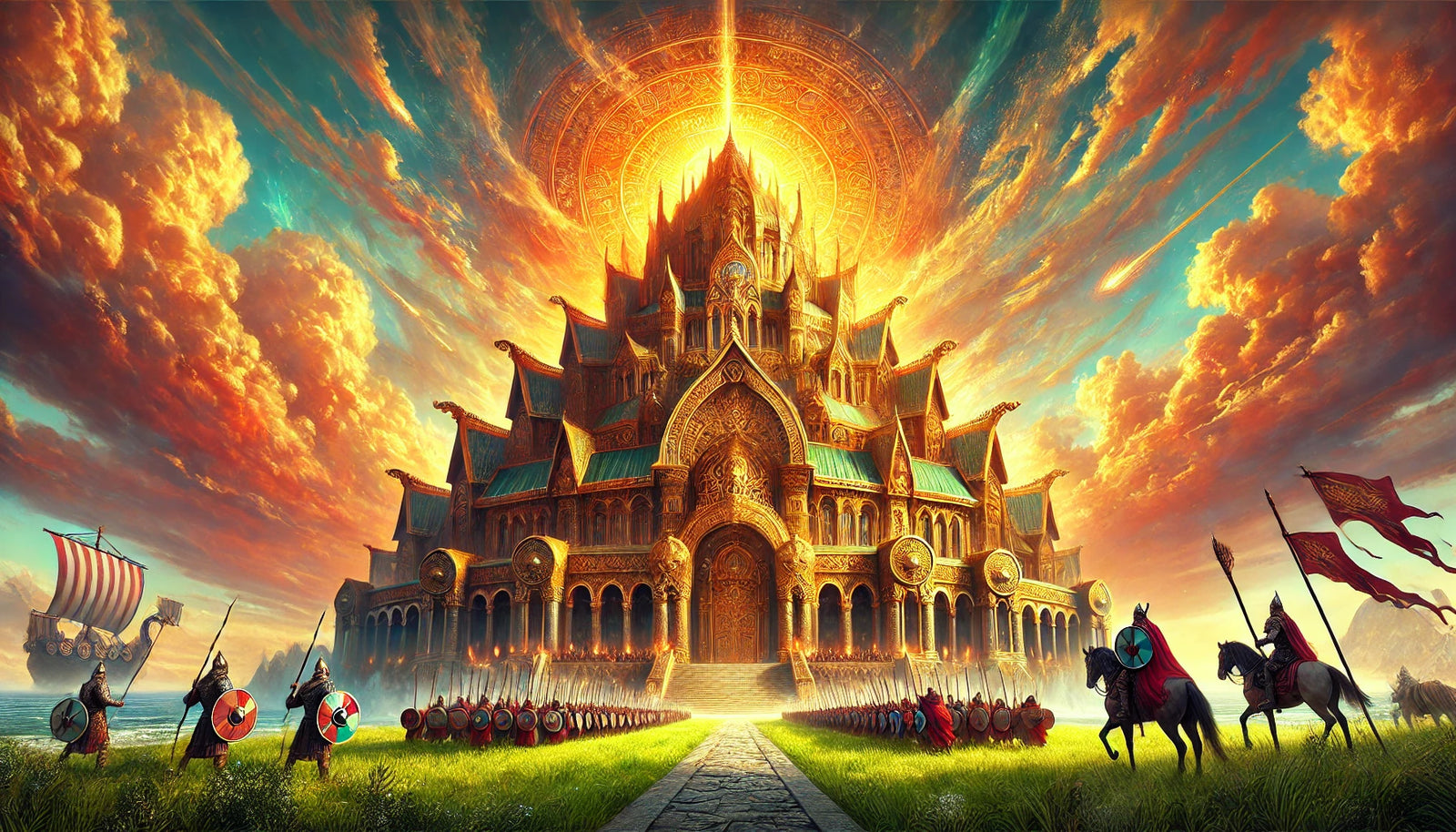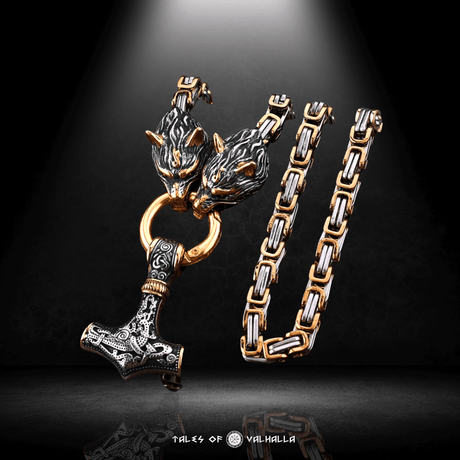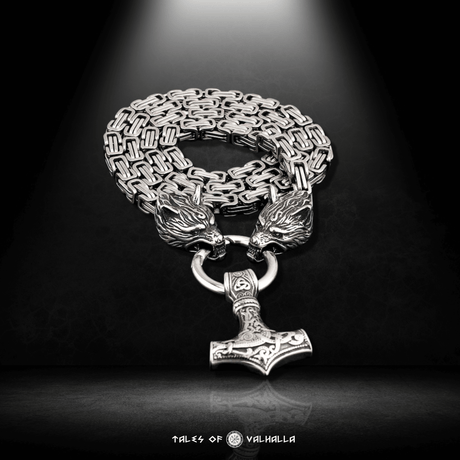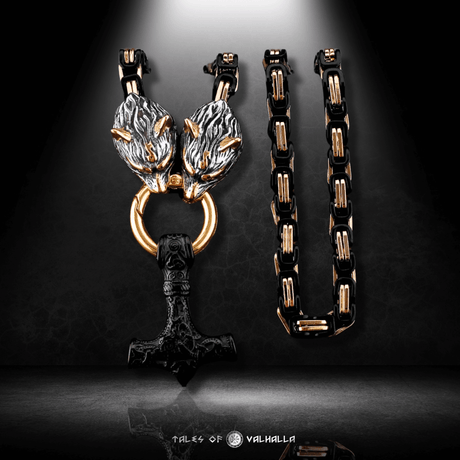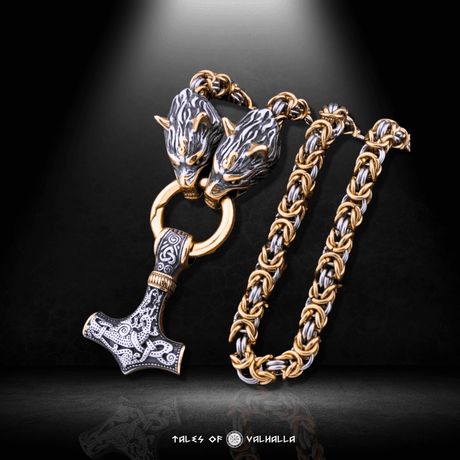In the vast and enigmatic world of Norse mythology, few concepts are as iconic or as revered as Valhalla. Known as the Hall of the Slain, Valhalla stands as a symbol of ultimate honor and bravery, a place where only the mightiest of warriors, the Einherjar, find eternal rest and glory. Governed by Odin, the Allfather, Valhalla is not just a mythological afterlife but a reflection of the values, beliefs, and aspirations of the Norse people. This blog delves into the origins, structure, and cultural significance of Valhalla, exploring why it remains a powerful symbol of the warrior spirit to this day.
Origins and Meaning of Valhalla

Valhalla, derived from Old Norse "Valhǫll," literally translates to "hall of the slain." This grand hall is located in Asgard, the realm of the gods, and is presided over by Odin, the chief of the Aesir gods. The concept of Valhalla first emerges in the ancient Norse texts known as the Poetic Edda and the Prose Edda, written in the 13th century by Icelandic scholars who compiled earlier oral traditions and myths. However, the idea of Valhalla likely dates back much earlier, rooted deeply in the Viking Age and the warrior culture that defined Norse society.
Valhalla is not merely a resting place for the dead; it is a reward for those who have proven their valor in battle. The Einherjar, the chosen warriors of Odin, are those who have died a heroic death on the battlefield. They are brought to Valhalla by the Valkyries, Odin's warrior maidens, who scour the battlefields for the bravest of the slain. The selection process by the Valkyries emphasizes the importance of courage and strength in Norse culture, where dying in battle was seen as the highest honor, granting a warrior eternal life in the company of the gods.
The Structure and Description of Valhalla
Valhalla is described in vivid detail in the Eddas, painting a picture of a grand and awe-inspiring hall. According to the Prose Edda, Valhalla has 540 doors, through which 800 warriors can pass side by side. The hall is roofed with shields, and the walls are adorned with spears, reflecting the martial nature of its inhabitants. The benches are covered with chainmail, and the Valkyries serve endless feasts of boar meat and mead, which is replenished each day. The boar, Sæhrímnir, is cooked every day and resurrected each evening, providing a never-ending supply of food for the warriors.
The daily life of the Einherjar in Valhalla is one of continuous battle and celebration. Each day, the warriors arm themselves and engage in combat, honing their skills and preparing for Ragnarok, the end-of-the-world battle in Norse mythology. After a day of fierce fighting, they are resurrected, their wounds healed, and they feast together in the evening. This cycle of battle, death, and resurrection underscores the Norse belief in the cyclical nature of life and death, as well as the eternal readiness of the warriors for the final conflict.
Valhalla’s structure and rituals also symbolize the ideal of eternal glory and camaraderie. The hall is not just a place of rest, but a continuation of the warrior’s life, where the valor of the battlefield is celebrated daily. The presence of Odin, the god of war, wisdom, and death, further cements Valhalla as a place of ultimate honor, where the fallen warriors are not just remembered but revered for their bravery.
The Role of Odin in Valhalla

Odin, the Allfather, plays a central role in the concept of Valhalla. As the ruler of Asgard and the god of war, wisdom, and death, Odin’s relationship with Valhalla is deeply intertwined with his character and his goals. Odin is often depicted as a wise, yet enigmatic figure, who is constantly seeking knowledge and preparing for the inevitable doom of Ragnarok. To this end, Odin gathers the greatest warriors in Valhalla, assembling an army that will fight alongside him in the final battle against the giants and other forces of chaos.
Odin’s motivation for creating Valhalla and selecting the Einherjar is rooted in his foreknowledge of Ragnarok. According to prophecy, Ragnarok will be a cataclysmic event in which many of the gods, including Odin himself, will perish. However, Odin does not face this fate passively; instead, he actively prepares for it by gathering the strongest warriors in Valhalla. The Einherjar are not just honored dead; they are Odin’s chosen soldiers, destined to fight in the ultimate battle for the survival of the world.
Odin’s role in Valhalla also reflects his dual nature as both a god of war and a god of wisdom. While he is a fearsome warrior, Odin is also deeply concerned with the pursuit of knowledge and the mysteries of the universe. He sacrifices one of his eyes to gain wisdom from the Well of Mimir, and he hangs himself on Yggdrasil, the World Tree, to gain knowledge of the runes. This quest for knowledge is reflected in the way Odin selects the Einherjar, choosing only those who have proven their worth in battle and are thus worthy of entering Valhalla.
Valhalla vs. Other Norse Afterlife Realms

In Norse mythology, the afterlife is not a singular concept, but rather a collection of realms, each with its own significance and purpose. Valhalla is one of several destinations for the dead, and it stands in contrast to other afterlife realms such as Helheim, Fólkvangr, and Helgafjell.
Helheim is the realm of the dead who did not die a heroic death. Ruled by the goddess Hel, this gloomy and cold realm is the final resting place for those who succumbed to illness, old age, or other non-violent means. Unlike Valhalla, Helheim is not a place of honor, but rather a neutral, sometimes bleak, continuation of existence.
Fólkvangr, another afterlife realm, is ruled by the goddess Freyja. Like Valhalla, Fólkvangr is a hall for warriors, but it serves a different purpose. Freyja shares the slain warriors with Odin, and those who come to Fólkvangr are also honored, though their role in Ragnarok is less prominent than that of the Einherjar in Valhalla.
Helgafjell, or "holy mountain," is a peaceful afterlife where the souls of the deceased live in harmony. It is believed to be a serene place, free from the conflicts and battles that define Valhalla. Those who led good lives, whether warriors or not, could find their way to Helgafjell, enjoying a restful and content existence.
The distinctions between these realms highlight the diversity of Norse beliefs about the afterlife. While Valhalla is reserved for the bravest and most honorable warriors, other realms cater to different types of people, reflecting the complex and multifaceted nature of Norse cosmology.
Valhalla’s Influence on Viking Culture and Beyond
Valhalla’s influence on Viking culture is profound. The concept of an afterlife where warriors continue to fight and feast eternally served as a powerful motivator for the Viking warriors. It encouraged them to face death fearlessly, knowing that a heroic death on the battlefield would grant them a place in Valhalla. This belief in Valhalla fueled the Vikings’ reputation as fierce and relentless fighters, willing to sacrifice their lives for the chance to join the ranks of Odin’s chosen warriors.
The idea of Valhalla also reinforced the social hierarchy of Viking society, where warriors were revered and their deeds celebrated. It provided a spiritual justification for the warrior ethos, emphasizing the importance of bravery, honor, and loyalty. These values permeated Viking culture, influencing not only how they fought but also how they lived, governed, and interacted with other cultures.
In modern times, Valhalla has transcended its mythological origins to become a symbol of bravery and honor in popular culture. It has been depicted in various forms of media, including literature, films, video games, and art. For example, the Marvel Comics character Thor, based on the Norse god, often references Valhalla in his stories. Similarly, Valhalla has been featured in numerous video games, such as the popular "Assassin’s Creed: Valhalla," which explores Viking culture and mythology.
Valhalla’s enduring appeal lies in its representation of an idealized warrior culture, where courage and honor are rewarded with eternal glory. This concept resonates with modern audiences, who continue to find inspiration in the values embodied by Valhalla. Whether in the context of historical fiction, fantasy, or contemporary media, Valhalla remains a powerful symbol of the warrior spirit.
The Symbolism and Legacy of Valhalla

Valhalla’s symbolism extends beyond its role as a warrior’s afterlife. It represents the ultimate reward for bravery, a place where the fallen are not forgotten but celebrated for their deeds. Valhalla embodies the Norse belief in fate, where each person’s destiny is determined by their actions and their willingness to face death with courage.
The cyclical nature of life and death, as depicted in Valhalla, also reflects broader themes in Norse mythology. The daily battles and resurrections of the Einherjar symbolize the eternal struggle between order and chaos, a struggle that will culminate in Ragnarok. This cyclical view of the universe, where death is not an end but a part of a larger cosmic cycle, is a key aspect of Norse cosmology.
Valhalla’s legacy continues to influence modern interpretations of Norse mythology and Viking culture. It serves as a reminder of the values that defined the Norse people, values that continue to inspire those who seek to understand and connect with their Viking heritage. Whether through literature, art, or popular culture, Valhalla remains a symbol of the timeless appeal of courage, honor, and the warrior’s journey.
Conclusion
Valhalla, the eternal hall of warriors, stands as a testament to the bravery and honor that defined Norse culture. Its significance in Norse mythology goes beyond its role as an afterlife; it represents the ultimate reward for those who have proven their valor in battle. Governed by Odin, Valhalla is a place of eternal glory, where the fallen warriors prepare for the final battle of Ragnarok.
Valhalla’s influence on Viking culture and its enduring legacy in modern media and popular culture highlight its power as a symbol of the warrior spirit. It continues to captivate and inspire, serving as a reminder of the values that shaped the Norse people and their mythology.

